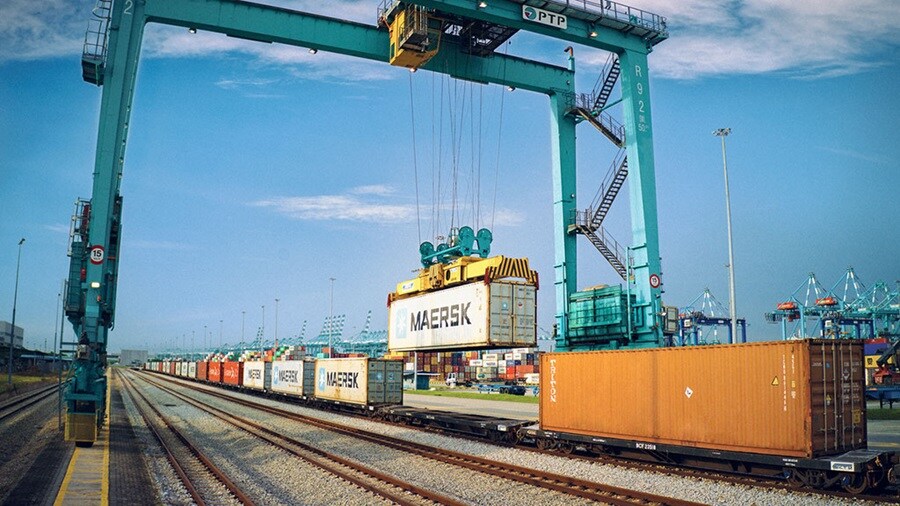Trade lanes between Asia and Europe have faced their fair share of disruptions over the past couple of years – from Covid-related port closures and congestions, to sanctions imposed against Russia in light of the ongoing conflict in Ukraine. In light of these challenges, businesses across the continent are looking for alternative routes and means of transporting cargo in a way that will not only ensure product availability on virtual and physical store shelves with the utmost reliability, but also in a way that supports decarbonisation as businesses’ focus on their greenhouse gas (GHG) emissions footprint continues to increase.
The so-called Middle Corridor through Central Asia provides a gateway for landlocked countries, and an important alternative route for Europe and China.
What is the Middle Corridor?
The Middle Corridor is the shortest route from China’s Pacific coast to Europe, spanning from China through Central Asia and Kazakhstan, across the Caspian Sea, to the South Caucasus region and further into Europe. In 2022, the route saw cargo transit volume increase two and a half times to a total of 1.5 million tons, setting a record for the corridor and showcasing its growth opportunity. “While the Corridor provides shorter transit time and lower GHG emissions compared to ocean, it does have a smaller capacity and a higher price tag than the ocean route. Weighing out these pros and cons is crucial for our customers, and the ones to benefit the most from the Middle Corridor route are customers with just-in-time production model,” explained Danelia.
Along this route, Kazakhstan, the largest landlocked country in the world, plays a crucial role as a transit country due to its strategic geographic location between Europe and Asia. The country has developed an extensive transportation infrastructure, including railways, roads, ports, and air transport, to facilitate the movement of goods across its territory and provide another solution for the implementation of the Silk Road initiative between East and West.
Kazakhstan’s strategic position in connecting Central Asia and Europe
Kazakhstan's transit potential is particularly important for the transportation of energy resources, such as oil and gas, from Central Asia to international markets, as well as agriculture and food products, machinery, and chemicals. The importance of the geographic position between East and West is demonstrated by Kazakhstan’s main export and import partners - China, Italy, Russia, Korea, the Netherlands, and Germany. Germany, for example, saw a 16.6% yearly increase, on average, in imports from Kazakhstan over the last 26 years.

A portion of the export cargo, to Germany and the rest of the continent, is transported across 17,000 kilometers of Kazakhstan railroad network. In the first half of the year, that rail network transported over 202 million tons of cargo, resulting in cargo turnover of over 162,991 million tonne-kilometers.
When Kazakhstan’s rail network ends at the Caspian Sea, cargo continues the Middle Corridor route via feeder service into Baku, Azerbaijan, where it continues its travel across Azerbaijan and into Gorgia, until it reaches the Black Sea port in Poti. While the Corridor saw a 63.7% growth in rail transport in the first quarter of 2023, further development agreements, such as a block train agreement and a multimodal agreement across the Caspian Sea, are planned for the coming years.
However, transporting cargo through several territories, each with their own set of regulations and charges, can sometimes result in increased costs or a less reliable service. For example, Kazakhstan has recently introduced an additional customs fee for transit cargo, making transit through the country more expensive. Doing business across several providers and territories can prove a time-consuming and costly task for a business.
“We see the importance of our participation in the process to create smooth connectivity for land locked central Asian countries to the rest of the world. By establishing important relations with countries along the corridor, we connect directly with strategic stakeholders to ensure a smooth and reliable service on this corridor.” explains Danelia.
The economic opportunity of Kazakhstan and Central Asia
Since Kazakhstan gained independence in 1991, it is not just the country’s infrastructure that saw a boost – Kazakhstan was one of the countries with the highest rate of GDP growth from 2001 to 2010. After a contraction of the economy between 2013 and 2016, the country is realising a continuous growth, predicted to reach 316.21 billion U.S. dollars in 2028. Biggest contributors to the GDP are industry with 29%, followed by wholesale and retail trade and repair of cars and motorcycles with 16.2%.
Beyond Germany, exports with the EAEU countries are also on the rise and currently at 2598.1 million US dollars in the first quarter of the year, 41.5% more than in the same period previous year. Foreign investments currently stand at a record inflow, with 28 billion US dollars in the last year, from approximately 40,000 foreign companies.

Likewise, the rest of the Central Asian region is experiencing a steady economic growth of 4% in 2023, which is predicted to continue in the coming two years thanks to advancements in structural reforms in the region. In exports, Uzbekistan is expected to see the biggest growth in trade from 16.04 billion USD last year, to 34.40 billion USD in 2027, while other Central Asian countries, such as Kyrgyzstan, Tajikistan, and Turkmenistan, are projected to see comparatively smaller growth over the next five years.
Economic growth and logistics performance go hand in hand – in order to secure import of goods needed for production and consumption and export of goods to the foreign markets, a country’s logistics infrastructure, including its providers, need to develop resilience and reliability to become a true driver of economic growth.
To help facilitate growth and supply chain resilience for customers, Maersk is strengthening their commitment to the countries of Central Asia. With a newly announced rail-sea service connecting China with Europe from Kazakhstan and the Caspian Sea, through Azerbaijan and Georgia to the Black Sea, Maersk offers customers an alternative connection to ocean. With shorter transit times, customers can ensure availability of goods on shelves at the time that they are needed, and with electrified rail service, customers can work towards lowering their GHG emissions.
Our recent launch of a cross-border railway solution marks a significant milestone. This tailored solution will efficiently link key industrial hubs in the West and countries in the Far East with Central Asian markets. With this solution and its primary focus on Kazakhstan, we pave the way for potential expansion into neighbouring countries like Uzbekistan, Turkmenistan, Tajikistan, and Kyrgyzstan.
Find out more about Maersk’s ocean-rail service through the Middle Corridor here.
Anything you need, we’re here to help
I agree to receive logistics related news and marketing updates by email, phone, messaging services (e.g. WhatsApp) and other digital platforms, including but not limited to social media (e.g., LinkedIn) from A. P. Moller-Maersk and its affiliated companies (see latest company overview). I understand that I can opt out of such Maersk communications at any time by clicking the unsubscribe link. To see how we use your personal data, please read our Privacy Notification.
By completing this form, you confirm that you agree to the use of your personal data by Maersk as described in our Privacy Notification.
